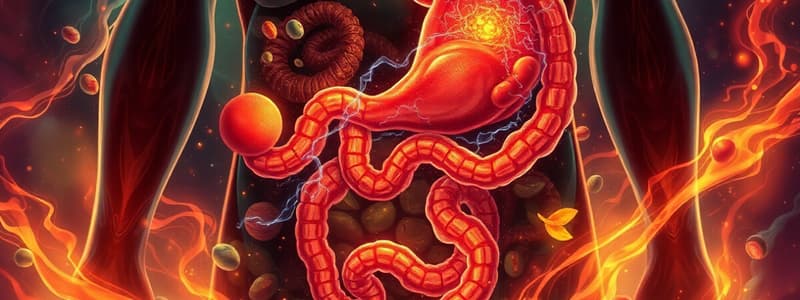Podcast
Questions and Answers
Which statement accurately describes the mechanical digestion process?
Which statement accurately describes the mechanical digestion process?
- Includes physical actions like chewing and stomach churning. (correct)
- Is primarily conducted in the small intestine.
- Focuses solely on the enzymatic action in the stomach.
- Involves enzymatic breakdown of carbohydrates into glucose.
What is the primary purpose of the respiration stage in digestion?
What is the primary purpose of the respiration stage in digestion?
- To absorb nutrients into the bloodstream.
- To eliminate undigested food from the body.
- To synthesize proteins from amino acids.
- To produce energy through metabolic pathways. (correct)
Which enzyme initiates protein digestion in the stomach?
Which enzyme initiates protein digestion in the stomach?
- Lipase
- Pepsin (correct)
- Amylase
- Trypsin
In which part of the digestive process does bile play a crucial role?
In which part of the digestive process does bile play a crucial role?
What occurs during the assimilation stage of digestion?
What occurs during the assimilation stage of digestion?
Which nutrient's digestion starts in the mouth and continues in the small intestine?
Which nutrient's digestion starts in the mouth and continues in the small intestine?
What is the correct sequence of nutrient digestion according to the processes described?
What is the correct sequence of nutrient digestion according to the processes described?
Which statement about excretion during digestion is true?
Which statement about excretion during digestion is true?
Which of the following correctly describes a key product of pyruvate oxidation?
Which of the following correctly describes a key product of pyruvate oxidation?
What do NADH and FADH₂ primarily serve as in cellular respiration?
What do NADH and FADH₂ primarily serve as in cellular respiration?
During the Krebs cycle, how many carbon dioxide molecules are produced per acetyl-CoA?
During the Krebs cycle, how many carbon dioxide molecules are produced per acetyl-CoA?
Which process occurs in the mitochondrial membrane and requires oxygen as the final electron acceptor?
Which process occurs in the mitochondrial membrane and requires oxygen as the final electron acceptor?
What is hypermetabolism primarily characterized by?
What is hypermetabolism primarily characterized by?
Which statement is true regarding insulin resistance?
Which statement is true regarding insulin resistance?
What is the role of Coenzyme A in pyruvate oxidation?
What is the role of Coenzyme A in pyruvate oxidation?
Which metabolic condition is characterized by a decreased metabolic rate?
Which metabolic condition is characterized by a decreased metabolic rate?
What is produced during oxidative phosphorylation in the electron transport chain?
What is produced during oxidative phosphorylation in the electron transport chain?
Which of the following best describes an anabolic process?
Which of the following best describes an anabolic process?
What is the primary purpose of food processing related to food safety?
What is the primary purpose of food processing related to food safety?
Which mechanical processing technique is most likely to cause nutrient loss due to heat generated by friction?
Which mechanical processing technique is most likely to cause nutrient loss due to heat generated by friction?
Which heat processing method preserves most nutrients due to its cooking mechanism?
Which heat processing method preserves most nutrients due to its cooking mechanism?
How does frying affect the nutrient content of food?
How does frying affect the nutrient content of food?
What is one of the main effects of pasteurization on food?
What is one of the main effects of pasteurization on food?
Which factor does NOT affect nutrient retention during food processing?
Which factor does NOT affect nutrient retention during food processing?
What is the role of emulsifiers in food processing?
What is the role of emulsifiers in food processing?
Which chemical food processing method is most associated with the preservation of proteins and minerals but can increase sodium content?
Which chemical food processing method is most associated with the preservation of proteins and minerals but can increase sodium content?
What is a negative consequence of hydrogenation in food processing?
What is a negative consequence of hydrogenation in food processing?
Which method of food processing is most effective for enhancing B-vitamin availability?
Which method of food processing is most effective for enhancing B-vitamin availability?
What impact does blanching have on nutrient retention in food?
What impact does blanching have on nutrient retention in food?
Which type of processing involves using salts or acids to preserve food?
Which type of processing involves using salts or acids to preserve food?
What is a common result of enzymatic browning in fruits and vegetables?
What is a common result of enzymatic browning in fruits and vegetables?
Which factor does NOT influence Basal Metabolic Rate (BMR)?
Which factor does NOT influence Basal Metabolic Rate (BMR)?
Which of the following is an accurate characteristic of low Glycemic Index (GI) foods?
Which of the following is an accurate characteristic of low Glycemic Index (GI) foods?
Which statement about the Harris-Benedict Equation is true?
Which statement about the Harris-Benedict Equation is true?
In the context of energy balance, which statement about negative energy balance is correct?
In the context of energy balance, which statement about negative energy balance is correct?
Which hormone is primarily responsible for signaling satiety?
Which hormone is primarily responsible for signaling satiety?
What is the primary role of non-exercise activity thermogenesis (NEAT)?
What is the primary role of non-exercise activity thermogenesis (NEAT)?
Which statement correctly describes glycolysis?
Which statement correctly describes glycolysis?
Which of the following best defines the concept of energy balance?
Which of the following best defines the concept of energy balance?
Which of the following is a consequence of a prolonged positive energy balance?
Which of the following is a consequence of a prolonged positive energy balance?
What are the components of Total Daily Energy Expenditure (TDEE)?
What are the components of Total Daily Energy Expenditure (TDEE)?
Which compounds are primarily responsible for rapid increases in blood sugar when consumed?
Which compounds are primarily responsible for rapid increases in blood sugar when consumed?
What is NOT a characteristic of metabolic syndrome?
What is NOT a characteristic of metabolic syndrome?
Which method is used for calculating the Glycemic Index (GI) of a food?
Which method is used for calculating the Glycemic Index (GI) of a food?
Which nutrient breakdown process occurs in the cytosol and is anaerobic?
Which nutrient breakdown process occurs in the cytosol and is anaerobic?
Flashcards
Digestion
Digestion
The process of breaking down food into smaller molecules that can be absorbed by the body.
Mechanical Digestion
Mechanical Digestion
Physical processes like chewing and churning food that break it down into smaller pieces.
Chemical Digestion
Chemical Digestion
Chemical reactions using enzymes that break down food molecules into simpler substances.
Absorption
Absorption
Signup and view all the flashcards
Carbohydrate Digestion
Carbohydrate Digestion
Signup and view all the flashcards
Protein Digestion
Protein Digestion
Signup and view all the flashcards
Fat Digestion
Fat Digestion
Signup and view all the flashcards
Energy Balance
Energy Balance
Signup and view all the flashcards
What is food processing?
What is food processing?
Signup and view all the flashcards
What is mechanical processing?
What is mechanical processing?
Signup and view all the flashcards
What is thermal processing?
What is thermal processing?
Signup and view all the flashcards
What is chemical processing?
What is chemical processing?
Signup and view all the flashcards
What is biological processing?
What is biological processing?
Signup and view all the flashcards
What factors affect how much nutrients are retained during processing?
What factors affect how much nutrients are retained during processing?
Signup and view all the flashcards
What happens to nutrients during baking?
What happens to nutrients during baking?
Signup and view all the flashcards
What happens to nutrients during microwaving?
What happens to nutrients during microwaving?
Signup and view all the flashcards
What happens to nutrients during frying?
What happens to nutrients during frying?
Signup and view all the flashcards
What happens to nutrients during grilling?
What happens to nutrients during grilling?
Signup and view all the flashcards
What happens to nutrients during boiling?
What happens to nutrients during boiling?
Signup and view all the flashcards
What happens to nutrients during steaming?
What happens to nutrients during steaming?
Signup and view all the flashcards
What happens to nutrients during blanching?
What happens to nutrients during blanching?
Signup and view all the flashcards
What happens to nutrients during grinding?
What happens to nutrients during grinding?
Signup and view all the flashcards
What happens to nutrients during chopping?
What happens to nutrients during chopping?
Signup and view all the flashcards
Basal Metabolic Rate (BMR)
Basal Metabolic Rate (BMR)
Signup and view all the flashcards
Glycemic Index (GI)
Glycemic Index (GI)
Signup and view all the flashcards
Low GI Foods
Low GI Foods
Signup and view all the flashcards
Medium GI Foods
Medium GI Foods
Signup and view all the flashcards
High GI Foods
High GI Foods
Signup and view all the flashcards
Thermic Effect of Food (TEF)
Thermic Effect of Food (TEF)
Signup and view all the flashcards
Non-Exercise Activity Thermogenesis (NEAT)
Non-Exercise Activity Thermogenesis (NEAT)
Signup and view all the flashcards
Basal Metabolic Rate (BMR)
Basal Metabolic Rate (BMR)
Signup and view all the flashcards
Physical Activity Level (PAL)
Physical Activity Level (PAL)
Signup and view all the flashcards
Positive Energy Balance
Positive Energy Balance
Signup and view all the flashcards
Negative Energy Balance
Negative Energy Balance
Signup and view all the flashcards
Glycolysis
Glycolysis
Signup and view all the flashcards
Metabolic Syndrome
Metabolic Syndrome
Signup and view all the flashcards
Metabolism
Metabolism
Signup and view all the flashcards
Micronutrients
Micronutrients
Signup and view all the flashcards
What is pyruvate oxidation?
What is pyruvate oxidation?
Signup and view all the flashcards
What is the Krebs cycle?
What is the Krebs cycle?
Signup and view all the flashcards
What is the electron transport chain?
What is the electron transport chain?
Signup and view all the flashcards
What is hypermetabolism?
What is hypermetabolism?
Signup and view all the flashcards
What is hypometabolism?
What is hypometabolism?
Signup and view all the flashcards
What is insulin resistance?
What is insulin resistance?
Signup and view all the flashcards
What is metabolism?
What is metabolism?
Signup and view all the flashcards
What is anabolism?
What is anabolism?
Signup and view all the flashcards
What is catabolism?
What is catabolism?
Signup and view all the flashcards
What is homeostasis?
What is homeostasis?
Signup and view all the flashcards
Study Notes
Digestion, Absorption, Metabolism, and Energy Balance
- Digestion is the process of converting ingested nutrients into absorbable forms. It involves mechanical (e.g., chewing) and chemical (enzymatic) processes.
- Stages of feeding:
- Ingestion: Consumption of food.
- Digestion: Mechanical (chewing, churning) and chemical (enzymatic breakdown).
- Carbohydrates: Broken down by amylase.
- Proteins: Broken down by proteases (e.g., pepsin).
- Fats: Broken down by lipases into fatty acids and glycerol.
- Absorption: Nutrients enter the bloodstream/lymphatic system.
- Assimilation: Nutrients used for energy, growth, and repair.
- Respiration: Metabolic pathways like glycolysis, Krebs cycle.
- Excretion/Egestion: Removal of waste and undigested matter.
- Digestion of Nutrients:
- Carbohydrates: Digestion begins in the mouth with salivary amylase; further breakdown in the small intestine by pancreatic amylase.
- Proteins: Begins in the stomach with pepsin and HCl; further breakdown in the small intestine with enzymes like trypsin and chymotrypsin.
- Lipids (Fats): Begins in the small intestine; bile emulsifies fats, lipase breaks them down.
- Food Processing:
- Methods to transform raw ingredients into consumable products.
- Reasons: Food safety, enhanced quality, increased convenience.
Categories of Food Processing
- Mechanical: Grinding, chopping, mixing.
- Thermal: Baking, frying, boiling, steaming.
- Chemical: Preservatives, colorants, flavor enhancers.
- Biological: Fermentation, enzymatic reactions.
Impact of Processing on Nutrient Content
- Nutrient retention depends on chemical stability, extent of processing, environmental conditions, and food form (fresh, frozen, canned).
Heat Processing Techniques
- Baking (Dry Heat): Loss of heat-sensitive vitamins (thiamin, vitamin C).
- Microwaving: Retains some vitamins and minerals.
- Frying: May lose water-soluble vitamins but retains fat-soluble ones.
- Grilling: Moderate loss of water-soluble vitamins.
- Boiling: Significant loss of water-soluble vitamins.
- Steaming: Preserves most nutrients.
- Blanching: Reduces nutrient loss by limiting cooking time.
- Pasteurization: Kills pathogens while preserving nutritional quality.
Mechanical Food Processing
- Grinding: Reduces particle size, increases surface area, may cause some nutrient loss (depending on refinement).
- Chopping: Breaks food into smaller pieces; minimal nutrient loss unless oxidation occurs.
- Blending: Liquefies/purees food; may degrade heat-sensitive vitamins; increases some nutrient bioavailability (like carotenoids).
Chemical Food Processing Techniques
- Uses additives to preserve, enhance, and modify food.
- Preservatives: Prevent spoilage (e.g., sodium benzoate).
- Antioxidants: Prevent oxidation (e.g., vitamin C).
- Flavor Enhancers: Enhance taste.
- Color Additives: Restore or enhance color.
- Sweeteners: Provide sweetness.
- Emulsifiers: Combine incompatible ingredients.
- Thickeners/Stabilizers: Improve texture.
- pH Control Agents: Maintain desired acidity/alkalinity.
- Anti-Caking Agents: Prevent clumping.
- Leavening Agents: Cause gases for light texture.
Common Chemical Processing Methods
- Curing/Salting: Draws out moisture; preserves protein and minerals; increased sodium content.
- Pickling: Preserves food by acidity; may reduce water-soluble vitamins.
- Emulsification: Mixes ingredients with emulsifiers.
- Hydrogenation: Converts unsaturated fats to solid fats (unhealthy trans fats).
- Acidification: Lowers pH to inhibit bacterial growth.
Biological Food Processing Techniques
- Fermentation: Uses microorganisms to convert sugars; enhances B-vitamins and probiotics.
- Enzymatic Browning: A reaction causing fruits/vegetables to brown due to oxidation; prevent by controlling pH, temperature, or using antioxidants.
Energy Balance
- Basal Metabolic Rate (BMR): Minimum energy for basic functions (60-75% daily expenditure).
- Factors affecting BMR: Age, gender, body composition, genetics, hormones, temperature.
- BMR Calculation: Harris-Benedict Equation (men/women); simplified estimate (24 kcal/kg/day).
- Glycemic Index (GI): Ranking of carbohydrates based on blood glucose rise.
- Low GI: Gradual rise (e.g., oats).
- Medium GI: Moderate rise (e.g., brown rice).
- High GI: Rapid rise (e.g., white bread).
Glycemic Index Calculation
- 50g of available carbohydrates are given to participants.
- Blood glucose measured over 2 hours.
- Compared to a reference food (glucose/white bread).
- Average blood glucose response determines GI score.
Energy Balance Concepts
- Energy Balance: Calories consumed = calories burned; crucial for weight maintenance.
- Positive Energy Balance: More calories in than out; weight gain.
- Negative Energy Balance: More calories out than in; weight loss.
- Total Daily Energy Expenditure (TDEE): Components: BMR, TEF (Thermic Effect of Food), PAL (Physical Activity Level), NEAT (Non-Exercise Activity Thermogenesis).
Factors influencing Energy Balance
- Diet composition: High protein increases TEF.
- Physical activity: Boosts calorie expenditure and muscle mass.
- Metabolic Rate: Varies with factors mentioned earlier.
- Genetics: Influences metabolism.
Regulation of Energy Balance
- Hormonal Regulation: (e.g., insulin, glucagon, leptin, ghrelin)
- Neurological Signals: Hypothalamus controls hunger and satiety.
Nutritional and Metabolic Disorders
- Obesity: Prolonged positive energy balance; associated risks.
- Underweight/Malnutrition: Chronic negative energy balance; associated risks.
- Metabolic Syndrome: Cluster of conditions (insulin resistance, high blood pressure).
- Eating Disorders: Anorexia nervosa, bulimia, binge-eating disorder.
Key Metabolic Processes
- Glycolysis: Breakdown of glucose to pyruvate; ATP and NADH produced.
- Pyruvate Oxidation: Pyruvate to Acetyl-CoA; CO2, NADH, and Acetyl-CoA produced.
- Krebs Cycle: Cyclic reactions producing ATP, NADH, and FADH₂ from Acetyl-CoA.
- Electron Transport Chain (ETC): Transferring electrons for ATP generation; oxygen as final electron acceptor.
Energy Balance and Metabolic Disorders
- Hypermetabolism: Increased metabolic rate leading to weight loss.
- Hypometabolism: Decreased metabolic rate causing weight gain.
- Insulin Resistance: Cells not responding to insulin leading to high blood sugar.
Key Definitions and Medical Terms
- Metabolism: All chemical reactions in the body.
- Anabolism: Building complex molecules.
- Catabolism: Breaking down complex molecules.
- Homeostasis: Maintaining stable internal conditions.
- Enzyme: Protein speeding up reactions.
- ATP: Primary energy carrier.
- Gluconeogenesis: Creating glucose from non-carbohydrates.
- Lipolysis: Breakdown of fats.
- Ketosis: Using fat-derived ketones for energy.
Studying That Suits You
Use AI to generate personalized quizzes and flashcards to suit your learning preferences.




